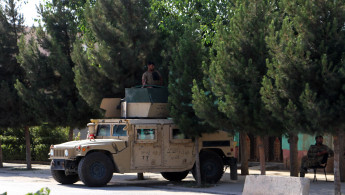Taliban have seized 50 of Afghanistan's 370 districts in new push as US forces withdraw
The Taliban have seized 50 of Afghanistan's 370 districts since May, according to the United Nations Secretary-General's Afghanistan envoy, as the country awaits the withdrawal of foreign forces.
Most districts seized by the group surround provincial capitals, suggesting the Taliban are preparing to take those cities once US and other foreign forces fully withdraw from Afghanistan, Deborah Lyons told the UN's security council on Tuesday.
Over the past 24 hours, the insurgents have taken control of numerous districts in Kunduz province - Chahar Dara, Khan Abad, Imam Sahib, to name a few. The last time the insurgents held the city of Kunduz itself was briefly in 2016.
Crucially, Afghanistan's main border crossing with Tajikistan is no longer under government control. Shir Khan Bandar, a dry port on the south bank of the Panj river, is capable of handling 1,000 vehicles a day. The loss will likely come with heavy financial consequences for the government.
South of Kunduz, scores of locals are said to have organised into anti-Taliban militias in Parwan and Baghlan, as well as west in Balkh, anticipating possible Taliban advances on their cities.
Afghanistan’s TOLO News on Tuesday broadcast images of swathes of fighters brandishing rifles and rocket launchers in Jabal Al Saraj in Parwan, raising their fists in the air and chanting: "We will defend our land."
"Parwan should prepare 10,000 forces to defend Parwan and other neighboring provinces," Noor Habib Gulbahari, a former mujahedeen commander in Parwan, told TOLO.
The report suggests that the fighters are ordinary civilians who have taken up arms, while the Taliban are known for their battle-hardened militants.
Sangar Paykhar, Afghan analyst and co-creator of the Afghan Eye podcast, told The New Arab the men are pro-government militias from the ranks of the Northern Alliance, a group deeply embedded in local government and the Kabul administration.
Despite President Ashraf Ghani’s past attempts to arrest and supress local mujahideen commanders, such as those of the Hezb e Islami and Jamiat e Islami, the same militia networks are tacitly propped up by the Kabul regime.
Their mobilisation comes amid reports of Afghan security force readily surrendering to the Taliban.
The insurgents have maintained their strategy of seizing chokepoints around cities, eliciting help from tribal elders who act as mediators during sieges and enabling the Taliban to make gains without firing a bullet.
In the absence of US air support and waning morale, analysts predict that Afghan forces will struggle to keep up their fight. On Saturday, President Ashraf Ghani ordered a shakeup of two key defence posts, in a move signalling desperation among the governing elite.
Paykhar believes that the Taliban are unlikely to exert substantial efforts in consolidating control over the north, since they understand a government counter-offensive could reverse those gains.
"I think it's a show of force. The Taliban are saying that we can go where we want to and take anywhere," Paykhar said.
"They are trying maintain leverage over Kabul and stimulate the prying eyes of Western media coverage."





 Follow the Middle East's top stories in English at The New Arab on Google News
Follow the Middle East's top stories in English at The New Arab on Google News


